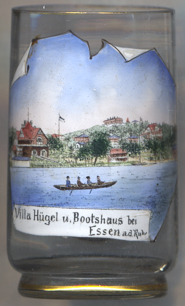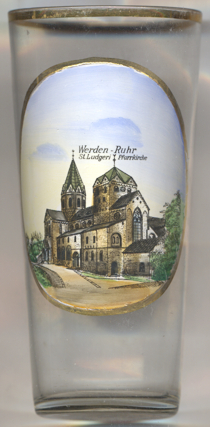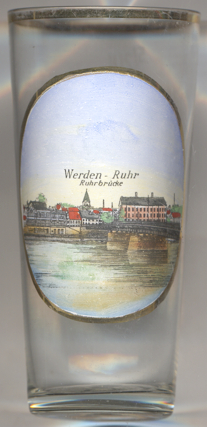

|
| DEUTSCHLAND | GERMANY |
| Bundesland: Nordrhein-Westfalen | North Rhine-Westphalia |
| Regierungsbezirk: Düsseldorf | |
| Stadt: Essen |
Essen is situated at an elevation of 107 m on the river Ruhr in central North Rhine-Westfalia. The name is derived from the Old High German word Asnidhi, meaning an area with ash trees. Around AD 799 a Benedictine monastery was founded in Werden (today part of Essen, see below). The monastery became one of the foremost ecclesiastical and intellectual centres in medieval Europe and obtained the rank of an Imperial abbey in 877. The foundation of the nunnery of Essen in 852 was a major historical factor for the development of the town. The nunnery gained such a great influence that Emperor Friedrich II elevated the abbess to the rank of a princess of the empire in 1216. In 1290, the German King Rudolf I granted the nunnery the lordship over the town. Coal mining in the area started in 1317, when the first deposits were found. Weapon manufactures operated in Essen since 1470. Although the citizens of Essen gained more rights in 1377, they only became fully independent from the nunnery after the secularisation in 1802.
Coal became a major economical factor in the early 19th century when underground mining was introduced in 1809 after the introduction of
steam engines. This was also the basis for the development the steel industry. The Krupp steel works were founded by
Friedrich Krupp already in 1811. When Friedrich died in 1826, the almost bankrupt firm was taken over by his son, Alfred, who was only 14 at that
time. Alfred Krupp (1812–1887) introduced new techniques and soon turned the company into the world's largest and most successful
cast steel corporation. By 1864, 22% of the inhabitants of Essen worked for Krupp. During World War II, Essen was almost completely destroyed.
After 1946, the reconstruction of the modern town was led by Essen's mayor, Gustav Heinemann, who later became the 3rd President of the
Federal Republic of Germany (1969–1974). The coal crisis of the 20th century hit the whole region hard: between 1958 and 1986 all coal mines had to close.
The last mine, Zeche Zollverein, was converted into an industrial museum and waslisted as a UNESCO World Cultural Heritage in 2001.
Together with Pécs and Istanbul, Essen was selected to be European Capital of Culture for 2010.


The sumptious mansion  Villa Hügel [left, no. 990: top picture, and right, no. 2082] was designed and built in 1870–1873 by Alfred Krupp
as home and representative residence for his family. Remodelled several times by his descendants, the mansion today has 269 rooms. It was the home of
four generations of the Krupp family. Alfred Krupp was followed by his son Friedrich Alfred Krupp,
then Friedrich Alfred's daughter Bertha and her husband Gustav von Bohlen und Halbach (who took the name Krupp von Bohlen und Halbach at their marriage).
The last personal owner of the Krupp steel works was Bertha's and Gustav's son, Alfred Krupp von Bohlen und Halbach. In 1948 Alfred Krupp was
convicted for using slave labor during the Nazi period. He was sentenced to 12 years in prison but was released in 1951. The
Villa Hügel was used as the seat of the British-American Control Commission from 1945 until 1952. Since 1955/56 the villa is the seat of the
Cultural Foundation Ruhr and the Alfred Krupp von Bohlen und Halbach Foundation.
Villa Hügel [left, no. 990: top picture, and right, no. 2082] was designed and built in 1870–1873 by Alfred Krupp
as home and representative residence for his family. Remodelled several times by his descendants, the mansion today has 269 rooms. It was the home of
four generations of the Krupp family. Alfred Krupp was followed by his son Friedrich Alfred Krupp,
then Friedrich Alfred's daughter Bertha and her husband Gustav von Bohlen und Halbach (who took the name Krupp von Bohlen und Halbach at their marriage).
The last personal owner of the Krupp steel works was Bertha's and Gustav's son, Alfred Krupp von Bohlen und Halbach. In 1948 Alfred Krupp was
convicted for using slave labor during the Nazi period. He was sentenced to 12 years in prison but was released in 1951. The
Villa Hügel was used as the seat of the British-American Control Commission from 1945 until 1952. Since 1955/56 the villa is the seat of the
Cultural Foundation Ruhr and the Alfred Krupp von Bohlen und Halbach Foundation.

The  monument for Friedrich Alfred Krupp [left, no. 990: bottom right] was erected in 1903. It was commissioned
by the employees of the Krupp company in gratitude for the workers colony Altenhof I, which had been set up by Friedrich Alfred Krupp in 1893–1907.
Most parts of the colony were torn down in the early 1980s in order to make room for the Alfred Krupp Hospital.
monument for Friedrich Alfred Krupp [left, no. 990: bottom right] was erected in 1903. It was commissioned
by the employees of the Krupp company in gratitude for the workers colony Altenhof I, which had been set up by Friedrich Alfred Krupp in 1893–1907.
Most parts of the colony were torn down in the early 1980s in order to make room for the Alfred Krupp Hospital.
Glass no. 2083 [near right] shows a view of
 Krupp's
Krupp's

The  old municipal theatre (Altes Stadttheater) [far left, no. 990: bottom left, and near left, no. 4043]
was commissioned by the industrialist Friedrich Grillo (1852–1888). The theatre, designed by the architect Heinrich Seeling, could only be built after
his death and was opened in 1892. It was damaged during World War II and was rebuilt in 1950, albeit without the original ornate Neo-Classical
decorations. After a thorough renovation in was reopened in 1990 and now bears
the name Grillo-Theater.
[https://de.wikipedia.org/wiki/Grillo-Theater]
old municipal theatre (Altes Stadttheater) [far left, no. 990: bottom left, and near left, no. 4043]
was commissioned by the industrialist Friedrich Grillo (1852–1888). The theatre, designed by the architect Heinrich Seeling, could only be built after
his death and was opened in 1892. It was damaged during World War II and was rebuilt in 1950, albeit without the original ornate Neo-Classical
decorations. After a thorough renovation in was reopened in 1990 and now bears
the name Grillo-Theater.
[https://de.wikipedia.org/wiki/Grillo-Theater]

The  Stadthalle (Städtischer Saalbau) [left, no. 1331: top left] was built in 1904 and replaced an earlier event hall of 1864.
The building was destroyed in 1943 during World War II. The new Saalbau was opened in 1950 and serves as concert, event and congress hall.
Stadthalle (Städtischer Saalbau) [left, no. 1331: top left] was built in 1904 and replaced an earlier event hall of 1864.
The building was destroyed in 1943 during World War II. The new Saalbau was opened in 1950 and serves as concert, event and congress hall.
The  Kaiser-Wilhelm-Denkmal (monument for Emperor Wilhelm I) [left, no. 1331: top right]
was created by Hermann Volz and was unveiled in 1898.
Kaiser-Wilhelm-Denkmal (monument for Emperor Wilhelm I) [left, no. 1331: top right]
was created by Hermann Volz and was unveiled in 1898.

The  old town hall [left, no. 1331: bottom left, and right, no. 1064] was built in 1884–1885.
It was demolished in 1965. Essen's new, modern town hall was built in 1975–1979 and is the tallest (106 m high) town hall of Germany.
old town hall [left, no. 1331: bottom left, and right, no. 1064] was built in 1884–1885.
It was demolished in 1965. Essen's new, modern town hall was built in 1975–1979 and is the tallest (106 m high) town hall of Germany.


The pictures on glasses no. 2050 [left] and no. 3355 [right] show the old
 Hauptbahnhof (Central Station). It was opened in 1862 by the Bergisch-Märkische
Eisenbahn (east–west route Dortmund via Witten, Bochum-Langendreer,
Essen, Mülheim an der Ruhr to Duisburg). However, the station was not the first on Essen soil,
as the station Essen (today Essen-Altenessen) of the Köln–Minden Railroad was opened in 1847
(Köln-Deutz, Mülheim am Rhein, Düsseldorf,
Duisburg, Oberhausen, Altenessen, Gelsenkirchen, Wanne,
Herne, Castrop-Rauxel, Dortmund,
Hamm, Oelde, Rheda, Bielefeld, Herford,
Minden). The station suffered extensive damage in World War II and was almost completely
rebuilt in the 1950s and 1960s.
Hauptbahnhof (Central Station). It was opened in 1862 by the Bergisch-Märkische
Eisenbahn (east–west route Dortmund via Witten, Bochum-Langendreer,
Essen, Mülheim an der Ruhr to Duisburg). However, the station was not the first on Essen soil,
as the station Essen (today Essen-Altenessen) of the Köln–Minden Railroad was opened in 1847
(Köln-Deutz, Mülheim am Rhein, Düsseldorf,
Duisburg, Oberhausen, Altenessen, Gelsenkirchen, Wanne,
Herne, Castrop-Rauxel, Dortmund,
Hamm, Oelde, Rheda, Bielefeld, Herford,
Minden). The station suffered extensive damage in World War II and was almost completely
rebuilt in the 1950s and 1960s.

 Kurhaus Ruhrstein in Essen Bredeney was built in 1896 by the architect Ernst Knobloch.
After World War I it was still a popular destination for day excursions.
The building was demolished later.
Kurhaus Ruhrstein in Essen Bredeney was built in 1896 by the architect Ernst Knobloch.
After World War I it was still a popular destination for day excursions.
The building was demolished later.

Glass no. 4619 [near left] shows a view of the
 Bootshaus
Bootshaus

The former  abbey church Sankt Ludgerus [left, no. 4637] in Essen's bourough of Werden was built around
the year 799 together with the Werden monastery. After several large fires it was consecrated again in 1275. It is supposed to be one of the most beautiful
churches in Rhineland-Palatine and is a model example of the Rhenish 'transitional style' at the transition from the Romanesque to the Gothic period. After
the secularisation of the eccliastical territories in 1802, the church obtained the status of a parish church. In 1993 it was granted the papal title
of a Basilica minor (see list of other Basilicae minores depicted on glasses of this collection).
The relics of St. Liudger (b. ca. 742 in Utrecht, d. 809 near Billerbeck), the founder of the Werden monastery and of the bishopric
of Münster are buried in the crypt underneath the church. One of the treasures of the church include the 'Helmstedter Kreuz',
a guilded copper sculpture of Christ crucified, cast presumably around 1060.
abbey church Sankt Ludgerus [left, no. 4637] in Essen's bourough of Werden was built around
the year 799 together with the Werden monastery. After several large fires it was consecrated again in 1275. It is supposed to be one of the most beautiful
churches in Rhineland-Palatine and is a model example of the Rhenish 'transitional style' at the transition from the Romanesque to the Gothic period. After
the secularisation of the eccliastical territories in 1802, the church obtained the status of a parish church. In 1993 it was granted the papal title
of a Basilica minor (see list of other Basilicae minores depicted on glasses of this collection).
The relics of St. Liudger (b. ca. 742 in Utrecht, d. 809 near Billerbeck), the founder of the Werden monastery and of the bishopric
of Münster are buried in the crypt underneath the church. One of the treasures of the church include the 'Helmstedter Kreuz',
a guilded copper sculpture of Christ crucified, cast presumably around 1060.
[https://de.wikipedia.org/wiki/Werden#Die_ehemalige_Abteikirche_St._Ludgerus;
https://de.wikipedia.org/wiki/Helmstedter_Kreuz]

The view depicted on glass no. 4638 [near left] is labeled  Ruhrbrücke. A bridge on this site
was alrady mentioned in 1065. A wooden bridge supported by stone pillars was built around 1400, but was replaced by a stone bridge in 1533–1538.
This bridge was destroyed by a large flood in the winte of 1642/1643. After that, a ferry replaced the bridge for some 200 years. In 1853/1854, the
Königsbrücke ('King's Bridge'), a steel construction supported by stone pillars, was built. After becoming unsafe, that bridge was
finally demolished in 1932. The bridge depicted on glass no. 4638 seems to be the bridge constructed in 1932 just south of the former bridge. This new
bridgeagain was a stell construction, supported this time by concrete pillars. This bridge survived World War II but was finally replaced in 1968 by the
new Gustav-Heinemann-Brücke, constructed in prestressed concrete and named for Gustav Heinemann, mayor of Essen (1946–1949) and
later third Chancellor of the Federal Republic of Germany (1969–1974).
Ruhrbrücke. A bridge on this site
was alrady mentioned in 1065. A wooden bridge supported by stone pillars was built around 1400, but was replaced by a stone bridge in 1533–1538.
This bridge was destroyed by a large flood in the winte of 1642/1643. After that, a ferry replaced the bridge for some 200 years. In 1853/1854, the
Königsbrücke ('King's Bridge'), a steel construction supported by stone pillars, was built. After becoming unsafe, that bridge was
finally demolished in 1932. The bridge depicted on glass no. 4638 seems to be the bridge constructed in 1932 just south of the former bridge. This new
bridgeagain was a stell construction, supported this time by concrete pillars. This bridge survived World War II but was finally replaced in 1968 by the
new Gustav-Heinemann-Brücke, constructed in prestressed concrete and named for Gustav Heinemann, mayor of Essen (1946–1949) and
later third Chancellor of the Federal Republic of Germany (1969–1974).
[https://de.wikipedia.org/wiki/Gustav-Heinemann-Br%C3%BCcke_(Essen)]
![[scale]](lineal.jpg)